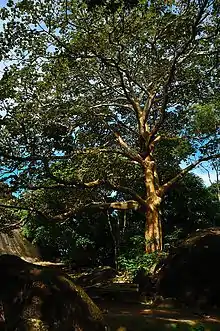Sterculia apetala
Sterculia apetala, commonly known as the Panama tree,[2] camoruco, manduvi tree or anacagüita,[3] is a species of flowering plants in the family Malvaceae.[1] It is found in Central and South America, as well as the Caribbean islands. Sterculia apetala is recognized as the national tree of the Republic of Panama.[4]
| Sterculia apetala | |
|---|---|
 | |
| On the bank of the Orinoco, Venezuela | |
| Scientific classification | |
| Kingdom: | Plantae |
| Clade: | Tracheophytes |
| Clade: | Angiosperms |
| Clade: | Eudicots |
| Clade: | Rosids |
| Order: | Malvales |
| Family: | Malvaceae |
| Genus: | Sterculia |
| Species: | S. apetala |
| Binomial name | |
| Sterculia apetala | |
| Synonyms[1] | |
| |
Description
Sterculia apetala is perennial and deciduous.[2] Trunks are straight, cylindrical, and have large buttresses at the base. Height ranges from 20–40 meters.[5]
Leaves are alternate, palmate with five lobes, and cluster densely at the end of branches. Including the petiole, leaf length ranges from 15-50 centimeters.[6]
Flowers are purple and yellow, and have five sepals. S. apetala flowers have no petals; structures that resemble them are in fact sepals. Flower diameter ranges between 2.5-3.5 centimeters. These flowers are dioecious, meaning there are distinct male and female individuals used for reproduction.[7]
Fruit are compounds of up to five follicles, stemming from peduncles that can reach as long as 30 centimeters. Inside the follicles are seeds, as well as orange urticating hairs that may cause pain when touched. Naturally, the tree typically flowers and bears fruit between December and March.[8]
Seeds are black ellipsoids, typically with the dimensions 2.5 x 1.5 centimeters.[4] These seeds contain sterculic acid and malvalic acid, two types of cyclopropene fatty acids.[9] Antioxidant compounds can be obtained from the seeds via continuous or batch extractions using water or ethanol as solvents.[10]
Taxonomy and nomenclature
Sterculia apetala belongs to the genus Sterculia, classified under the mallow family Malvaceae. Apetala is one of 150 known species of Sterculia.[11]
The generic name Sterculia is derived from the Latin word "stercus", which translates to "excrement". This is because of the strong odor characteristic of flowers and leaves within this genus.[4]
Distribution
Sterculia apetala is found in the tropical regions of Bermuda, Mexico, Barbados, Belize, Cuba, El Salvador, Guatemala, Honduras, Jamaica, Montserrat, Panama, Puerto Rico, Saint Kitts and Nevis, Trinidad and Tobago, Bolivia, Brazil, Colombia, Ecuador, Peru, and Venezuela.[12]
Uses
Wood from Sterculia apetala is used to produce cases, crates, industrial and domestic woodware, canoes, and tool handles. The tree is often grown for shade, resulting from its large leaves.[4][12] In some regions, seeds are consumed after being boiled or roasted, used to flavor chocolate, or given to animals as fodder.[9] The flowers are used as antitussive.[13]
Conservation
In the Pantanal wetlands of Central Brazil, the endangered hyacinth macaw (Anodorhynchus hyacinthinus) makes its nest almost exclusively in the natural hollows of S. apetala.[14]
Gallery
 Sterculia apetala tree and leaves
Sterculia apetala tree and leaves S. apetala fruit
S. apetala fruit S. apetala follicle and seeds
S. apetala follicle and seeds S. apetala fruit and flowers
S. apetala fruit and flowers_en_flor.JPG.webp) S. apetala flower cluster
S. apetala flower cluster S. apetala individual flowers
S. apetala individual flowers S. apetala old trees
S. apetala old trees S. apetala trunk and bark
S. apetala trunk and bark
References
- "Sterculia apetala (Jacq.) H.Karst". The Plant List. 2013. Retrieved 28 March 2015.
- "Sterculia apetala". Natural Resources Conservation Service PLANTS Database. USDA. Retrieved 3 December 2015.
- Roig, Juan Tomás (2014). Diccionario Botánico de nombres vulgares Cubanos. Edition Científico-Ténica. p. 77. ISBN 978-959-05-0713-7.
- Comisión Nacional para el Conocimiento y Uso de la Biodiversidad (CONABIO). "Sterculia apetala" (PDF). Gobierno de México.
- Fontoura, Fernanda Mussi; Matias, Rosemary; Ludwig, Juliane; Oliveira, Ademir Kleber Morbeck de; Bono, José Antonio Maior; Martins, Pedro de Figueiredo Rocha Barbosa; Corsino, Joaquim; Guedes, Neiva Maria Robaldo; Fontoura, Fernanda Mussi (September 2015). "Seasonal effects and antifungal activity from bark chemical constituents of Sterculia apetala (Malvaceae) at Pantanal of Miranda, Mato Grosso do Sul, Brazil". Acta Amazonica. 45 (3): 283–292. doi:10.1590/1809-4392201500011. ISSN 0044-5967.
- "Panama watershed tree atlas". ctfs.si.edu. Retrieved 2018-04-12.
- 1956-, Condit, Richard (2011). Trees of Panama and Costa Rica. Pérez, Rolando, 1963-, Daguerre, Nefertaris, 1969-. Princeton, N.J.: Princeton University Press. ISBN 9780691147109. OCLC 705945360.CS1 maint: numeric names: authors list (link)
- STRI. "Smithsonian Tropical Research Institute-Sterculia apetala". biogeodb.stri.si.edu. Retrieved 2018-04-16.
- Herrera-Meza, Socorro; Rodríguez-Landa, Juan Francisco; Martínez, Armando J.; Herrera-Meza, Grecia; Fernández-Demeneghi, Rafael; Reyes-Saldaña, Karla; Oliart-Ros, Rosa María (2017-11-01). "Behavioral Effect of Sterculia apetala Seed Oil Consumption in Male Zucker Rats". Journal of Medicinal Food. 20 (11): 1133–1139. doi:10.1089/jmf.2017.0006. PMID 28777691.
- Mosca, Federica; Hidalgo, Gádor Indra; Villasante, Juliana; Almajano, María Pilar (2018). "Continuous or Batch Solid-Liquid Extraction of Antioxidant Compounds from Seeds of Sterculia apetala Plant and Kinetic Release Study". Molecules. 23 (7): 1759. doi:10.3390/molecules23071759.
- "Malvaceae | plant family". Encyclopedia Britannica. Retrieved 2018-04-14.
- "Sterculia apetala (Panama tree)". www.cabi.org. Retrieved 2018-04-15.
- Roig, Juan Tomás (2016). Plantas medicinales, aromáticas o venenosas de Cuba; Tomo I. Edition Científico-Ténica. p. 140. ISBN 978-959-05-0663-5.
- Pizo, Marco Aurélio; Donatti, Camila I.; Guedes, Neiva Maria R.; Galetti, Mauro (2008). "Conservation puzzle: Endangered hyacinth macaw depends on its nest predator for reproduction". Biological Conservation. 141 (3): 792–796. doi:10.1016/j.biocon.2007.12.023.
External links
 Media related to Sterculia apetala at Wikimedia Commons
Media related to Sterculia apetala at Wikimedia Commons Data related to Sterculia apetala at Wikispecies
Data related to Sterculia apetala at Wikispecies